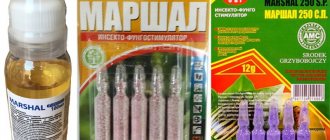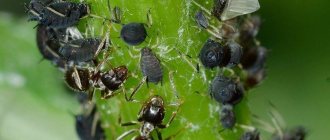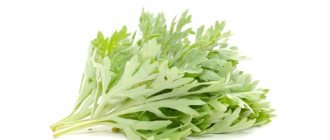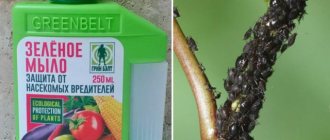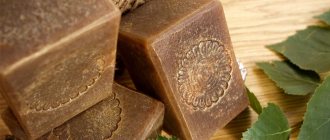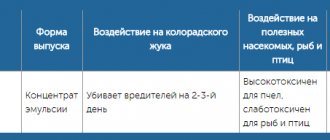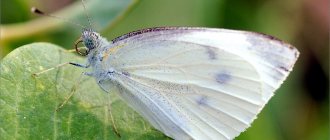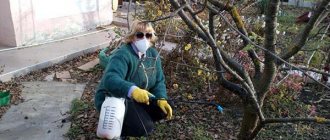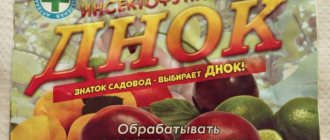The alkaloid nicotine, which is found in large quantities in tobacco leaves and stems, is a poison for many insects, working within plants as their natural protector against pests. And gardeners have known this for a long time.
Back in the 17th century, nicotine extracted from tobacco was already used as an insecticide, and a century later, plants affected by insects began to be treated with tobacco smoke. Why don't you try using this cheap and effective remedy to combat garden and vegetable pests?
Moreover, tobacco is not only an effective insecticide, but also a real fertilizer - in addition to alkaloids, it contains many useful organic and mineral substances that can enrich the soil.
How to properly use tobacco in the garden? There are several methods.
What is tobacco infusion used for?
Tobacco is often used as a natural supplement. To make an infusion for this purpose, tobacco dust is used. As a rule, it remains after tobacco production as waste. It can be found on store shelves in gardening departments. Tobacco waste contains phosphorus, potassium and nitrogen. They are so necessary for plants for intensive growth.
Studies have shown that tobacco-based products do not contain hazardous substances and alkaloids that can harm the fruit.
The infusion is non-toxic, has a positive effect on microorganisms in the soil and nourishes the plant with minerals. Thanks to this, the yield increases significantly. This infusion can also be used to fertilize indoor plants. It is especially effective during transplantation for better adaptation.
An infusion of tobacco will also help against pests and parasites: aphids, caterpillars, leaf rollers and others. The product is non-toxic, does not penetrate deep into the plant and does not pollute the soil, unlike chemical insecticides.
Application of the product
Tobacco dust is industrial waste from relevant factories, having the appearance of dust and the color corresponding to the raw material. In addition to tobacco, its composition also includes: nitrogen (up to 5%), potassium (up to 3%), phosphorus (up to 2%).
Bait is sold in any specialized store, you can learn about its use from this article, and it is very simple to treat an area with it against a pest or to feed plantings. Storage conditions are simple: keep the dry mass covered.
Tobacco dust is industrial waste from relevant factories
To understand why this supplement is needed, you need to know only two things:
- Adding it to the soil during digging will increase the yield by 40%, since it contains a considerable amount of useful substances.
- As an insecticide, this product will expel most pests and protect vegetables, fruits, berry bushes, and flowering vegetation from copperheads, aphids, flea beetles, and thrips.
To understand what makes it special, you should know:
- Tobacco dust can be used even during fruit ripening, when it is prohibited to spray them with most other means.
- It is completely natural, safe for humans and plants.
From pests
Tobacco infusion against pests is quite effective. To prepare the preparation, stems, dust and leaves are used. The main active ingredient is alkaloids. It will help get rid of such parasites as: aphids, copperheads, thrips, leaf roller caterpillars, cabbage moths, apple and fruit moths, onion flies, secretive moths, lacewings, moths, ringed silkworms, cruciferous flea beetles, spider mites, rapeseed and cherry sawfly larvae, whiteflies, slugs and even household moths.
Compound
- tobacco – 400 g;
- water – 10 l.
Preparation
- Grind the raw materials.
- To fill with water.
- Leave for 2 days.
- Squeeze out the liquid and strain through cheesecloth.
- Dilute with the same volume of water.
Used for pest-infected plants by spraying.
Spraying recommendations
For spraying with tobacco infusion to work, it is worth considering the following recommendations:
- before processing, liquid soap is added to the infusion at the rate of 40 g per 10 liters of water, which helps to better fix the product on the crops;
- try to spray the infusion when spraying along the tops of trees and bushes, because it is in this place that there is a high concentration of aphids;
- It is normal for plant leaves to change after treatment - a brown tint will be added due to the high concentration of the infusion.
Description of the insect
Aphids reach only 2-3 mm in length. She spends the winter in the egg phase on branches and shoots of bushes at the very base of the buds.
When the buds swell, the founding larvae emerge from the eggs and begin to harm the plant. Then, when the buds open, they proceed to damage the leaves and shoots of the tree.
| Note. Aphids cause the greatest damage to young shrubs. |
The insect reproduces quickly. Female larvae develop for about 2 weeks, after which they give birth to new individuals without fertilization. Immediately after birth, the pest begins to cause damage to garden crops.
In summer, aphids can produce up to 15 generations, covering the shoots and foliage of trees with a thick layer of larvae and founding females. Winged females also emerge from the eggs. Their goal is to populate as many new areas as possible.
The life cycle of insects comes to an end in late autumn, after the onset of the first frost. Before the onset of cold weather, they lay eggs, which will spend the next winter on the shoots and leaves of trees.
From aphids
Despite the large assortment of home and store-bought remedies for parasites, tobacco infusions for aphids occupy one of the leading positions.
Compound
- tobacco dust – 400 g;
- water - 10 l;
- soap – 40 g.
Preparation
- Pour water over tobacco dust.
- Leave for a day.
- Stir several times.
- Strain through double cheesecloth.
- Add soap.
Gardeners advise spraying against aphids every 5-7 days to remove all pests. To improve and accelerate effectiveness, you can alternate preparations from different types of raw materials.
Basic methods of struggle
Chemical insecticides are used to kill the pest. You can get rid of aphids on raspberries using folk remedies. This method is cheaper and does not harm the environment. Homemade recipes are chosen if there are few aphids. For insect infestations, synthetic fungicides are used.
Before treating the bush with a ready-made pesticide, neighboring plants that are not affected by harmful insects are covered with plastic film.
Garlic water
The spraying solution is prepared from plant shoots. Half a bucket of green mass is filled with five liters of water. Add 10–15 cloves of garlic. The crushed spice is soaked in boiling water and infused for 24 hours. The composition has a pungent odor that repels pests.
Read the article here for infusion of garlic against aphids, processing and methods of preparation.
Hot pepper
This is an effective remedy for aphids on raspberries. Pests cannot tolerate strong aroma. One teaspoon of pepper or crushed ripe pod is poured with a small amount of boiling water, covered tightly with a terry towel, and left for an hour. Before use, the concentrate is diluted in water in a ratio of 1:10.
Onion infusion
This option is often used by summer residents. The recipe for making the tincture is as follows:
- the peeled onion is crushed, ground, poured with warm water;
- recommended proportion – 0.5 kg/5 l;
- the solution is infused for three days, then filtered;
- squeeze out the resulting onion pulp.
The mass is diluted in water and sprayed on the raspberry bush to repel aphids, as well as other insect pests.
Tobacco dust
The product has a nerve-paralytic effect on insects. Effective against all types of aphids. Individuals quickly die from tobacco dust. The only drawback is that the substance is washed off by rain. The treatment is carried out using the dry pollination method or the raspberry fields are sprayed with a mixture of water in a proportion of 100 g. tobacco dust per liter.
Infusion of tomato tops
A kilogram of organic material is added to a bucket of water. Boil and stand for five hours. Spraying raspberries with this product helps remove aphids and other insect pests.
Laundry soap
The damaging properties of the product are explained by the increased content of fatty acids, in particular caproic acid. It destroys up to 90% of pests. Typical recipe:
- the soap is ground on a coarse grater;
- the shavings are filled with two liters of water;
- stir until a thick soap solution is formed;
- the concentrate is diluted with 8 liters of warm water.
If the aphid population is small, it is enough to treat the branches and foliage with the composition. In case of pest invasion, finely dispersed spraying of shrubs is performed.
Dandelion infusion
Treating berry bushes with such a solution not only destroys insect pests, but also inhibits pathogenic bacteria. Dandelion is a natural insecticide. To prepare the solution, the plant is crushed, filled with water, and left for 5 hours.
Formula milk
The animal product is mixed with iodine to spray raspberry fields. When dried, the milk forms a thin film, which protects the bushes from aphids and pathogenic microorganisms.
Tobacco dust
From waste in the production of tobacco factories, packaged packets of tobacco dust are produced for sale. Thanks to the rich content, plants receive improved nutrition and soil activity increases. In addition to the fact that tobacco dust is used when digging the soil and planting crops by adding it to the ground, a common method of application is an infusion of tobacco dust.
Tobacco dust contains nicotine, which fights parasites during the growth of garden plants. An infusion of tobacco dust is useful for protecting tobacco, cabbage, fruits and berries and flowers.
Compound
- tobacco dust – 400 g;
- a bucket of water.
Preparation
- Fill the main component with water.
- Leave for at least a day.
- Stir occasionally.
- Strain through cheesecloth.
- Dilute with water 1:2.
- Add a little soap.
Apply immediately after preparation. Spray at least 2 times a day. Take a break for several days between procedures.
An infusion of tobacco dust works effectively against pests when used correctly:
- to combat copperhead, spray fruit trees during the period when buds appear;
- when removing aphids, treat with infusion by spraying at intervals of a week;
- to combat gooseberry moth and raspberry beetle larvae, carry out treatment during bud break;
- when spider mites appear, spraying is carried out immediately after identifying the pests, and again after 7 days;
- from fleas - all crops are treated once a month;
- for cabbage flies and onion hoverflies, treatment is carried out 2 times: in the first half of June and at the end of August.
Treatment of plants with tobacco
It is no secret that every summer resident, resident of a rural area, when planting seedlings, shrubs or fruit trees, hopes to receive a bountiful harvest that will be the envy of their neighbors.
You will be lucky if, without putting in any work, you get an abundance of vegetables, fruits and flowers. Unfortunately, we cannot always trust chance and hope for the mercy of nature. A huge number of external factors can have a detrimental effect on your plantings, leaving at the end of the season instead of baskets full of fruits, disappointment and wilted bushes.
So who caused such irreparable damage to your country estate? The answer is simple - diseases and pests. There is no need to be upset, now on sale you can find a huge number of pesticides and chemicals that will literally destroy all parasites at the root, in the literal sense of the word. It would seem that everything is simple, but there is one small, but very big BUT...
Precautionary measures
Despite the fact that tobacco infusion against pests is non-toxic, it is worth adhering to some safety measures. Since careless use can cause health problems, you must:
- wear a cotton-gauze bandage to protect the respiratory tract;
- rubber gloves are used to protect the skin of the hands;
- eye protection glasses;
- If the drug gets on the skin and mucous membranes of the eyes or mouth, rinse thoroughly under running water.
- while carrying out work to get rid of pests, you must not smoke, drink or eat food;
- at the end of the procedure, wash your hands and face well with soap;
- Children, pregnant and lactating women, as well as people with allergies are not allowed to work with the infusion;
- preparations of dried raw materials for the drug must be done with gloves and scissors;
- store the prepared raw materials with signed labels, because not only fresh tobacco is used to make the infusion, but also dried tobacco;
- The dishes used for making the infusion must be washed with a solution of soda ash or wood ash, and then rinsed with plain water.
Thanks to tobacco infusion, you can get rid of almost any harmful insect for home crops. It is important that this method is not only effective, but also economical.
Bird cherry decoction
What it fights: aphids, leaf-eating caterpillars, slugs.
How to prepare: 200 g of crushed mass of flowers and young shoots of bird cherry are boiled in 5 liters of water for 15 minutes, allowed to brew for about a day. After this, the plants are filtered and sprayed - this can be done throughout the entire growing season.
How does soap work?
Laundry soap has been used by gardeners in our country for a very long time in pest control. This remedy was used back when chemical insecticides were just emerging. Using soap, you can not only drive aphids and ants out of your area, but also defeat some fungal plant diseases.
The pest-killing properties of laundry soap are based on the rich content of natural fatty acids in its composition. Scientists have already found out that one of the main components of soap, caproic acid, can kill up to 90% of aphids even in a very weakly concentrated solution.
It will also be useful to learn about what folk methods exist to combat aphids on currants.
However, the laundry soap itself has a complex composition, which in the proper concentration can easily kill aphids.
Therefore, highly concentrated solutions of laundry soap can also be used as a separate spraying agent. It will also be useful to learn about how to use tar soap and soda against aphids.
Note that cosmetic soap is not suitable for combating aphids - it is necessary to use laundry soap or tar soap. The fact is that these types of soap have the highest disinfectant and antibacterial properties.
In addition, today manufacturers have developed the so-called green soap - a special soap-based insecticide that can, among other things, protect an area from aphids and ants.
Horsetail decoction
What it fights: powdery mildew, rot, rust.
How to prepare: 50 g of dry horsetail, pour 1 liter of water and leave for 2-3 hours. Then the container with the infusion is placed on the fire and boiled for about 20 minutes. The broth is cooled, and before spraying the plants, it is filtered and diluted with water (1:5).
Fitoverm
Fitoverm is a very effective protection against aphids, since the drug is based on organic compounds. The active component in it is aversectin C, a substance produced by bacteria. That is why Fmitoverm can be used to treat plants in open ground, growing in greenhouses and even indoor flowers.
Fitoverm is a concentrated composition, packaged in dosed ampoules or bottles. To use it, prepare a working solution, the concentration of which depends on the level of contamination of garden crops. The optimal concentration of the solution is the ratio of 5 ml of product per 600 ml of liquid.
The price range of Fitoverm varies between 170-200 rubles.
Fitoverm for killing aphids
